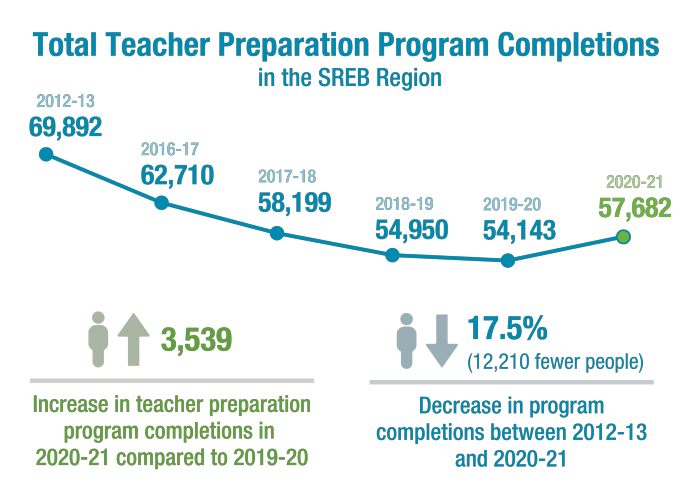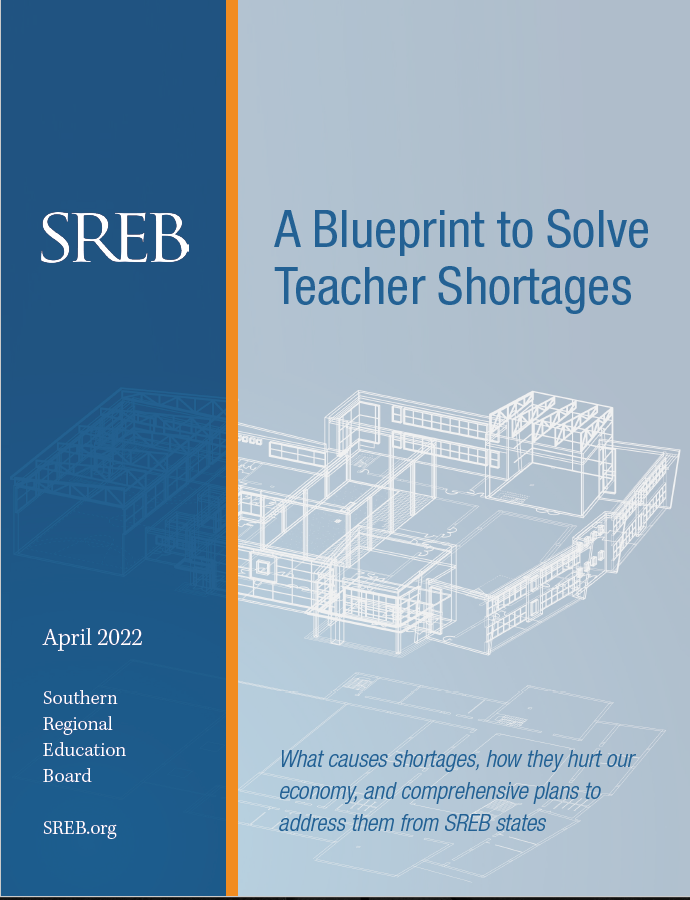Let’s give our teachers what any employee needs to be successful
 We have a public-school teacher vacancy
and turnover problem — more are leaving than coming in. In 2021,
turnover equated to a loss of over 152,000 teachers from their
positions in the SREB region. Yet we only prepared shy of 58,000
new teachers (traditional and alternative prep combined).
We have a public-school teacher vacancy
and turnover problem — more are leaving than coming in. In 2021,
turnover equated to a loss of over 152,000 teachers from their
positions in the SREB region. Yet we only prepared shy of 58,000
new teachers (traditional and alternative prep combined).
Teacher Workforce Data by State >
Nations with top education outcomes, such as Sweden, Finland, Hong Kong and Singapore, do three key things to raise and hold high esteem for the teaching profession:
- Support teachers with rigorous preparation and continuous development for mastery.
- Give teachers reasonable autonomy.
- Provide incentives by way of a professional salary.
Policymakers here at home can apply these strategies successfully too – we see examples in our schools. After all, as author and TED speaker Daniel Pink explains, autonomy, mastery and purpose, combined with fair pay, are integral to motivation, satisfaction and low turnover in all professions.
Mastery and Purpose
To develop stronger mastery in the U.S., we can focus on tighter quality control for teacher preparation programs — which is imperative to decreasing turnover. When teachers are well-prepared, they perform better and stay longer, and their sense of purpose is solidified.
The U.S. boasts more than 2,200 traditional and alternative preparation programs. In the South, a record high of 39% of teacher candidates complete alternative preparation programs (university and non-university based combined), who are prepared sometimes too quickly and turn over faster than traditionally prepared teachers.
State boards need to maintain rigor when approving or evaluating any teacher preparation program to ensure mastery and require the same high standards for every route. Additionally, the two most proven ways to make sure a teacher is well prepared are robust, weekly teacher-mentor engagements and requiring full-year clinicals as a teacher resident or apprentice before becoming a teacher of record.
Autonomy
Second, teachers want a reasonable amount of control over their classrooms, and if they are well prepared, they deserve this autonomy.
We can’t under-incentivize or undervalue a profession and keep talent.
Yet many say the current environment is eroding their autonomy and pushing out great teachers or administrators. Distrusting dedicated public school teachers and regulating them so they cannot respond to their students’ needs they way they decide is best deters passionate people from joining or staying in the profession.
Compensation
Third, teachers are a crucial engine for local economies. So why don’t we pay or incentivize the profession so teachers are able to support their families financially?
A movement has spread across the nation that calls for increasing base pay to $60,000. That’s about $30 an hour for a teacher on a 10-month contract at 50 hours per week. State base pay in the South sits between $28,000 and $44,000 as of 2021-22.
Public education cannot rely on altruism as the only way to attract educators.
Until state budgets can allocate a more professional starting pay, we might incentivize teaching with other financial levers. For example, payments on student loan debt could be deferred for public school teachers, or even cancelled entirely after teaching in a public school for seven years. Who better to attend college free than those who devote time to educating the next generation? Teachers’ pay goes further if they aren’t burdened by student loans.
Another idea: states that collect income tax could eliminate that tax for public school educators. This would amount to around $250 per month in the average teacher’s paycheck in the South – a modest loss in income for states at an average of $3,000 per teacher per year. And considering it costs schools on average more than $21,000 to replace a teacher, and turnover is edging toward 50% for those with fewer than three years of experience, a teacher who stays seven years to reap a free college incentive has already saved governments double or more on turnover costs.
SREB Teacher Compensation Dashboard >
Other incentives could include:
- Increased teacher tax credit for school supplies
- A draw-down account to cover the costs of annual, offsite quality professional learning
- Flexible scheduling to accommodate part-time certified teachers, onsite teacher mentors, team teaching with multi-classroom leaders, reach teachers and part-time residents or apprentices
- Wages for teacher residents and apprentices, who devote many hours working in a school and should earn at least a teacher assistant pay
- Portable, 403(b)-style retirement account options so teachers can invest and withdraw earnings throughout their careers. This also saves state allocations on pension costs through future unfunded liabilities.
We cannot rush underprepared and under-supported people into leading classrooms and think it will slow rising turnover or fill vacancies with impactful educators. Nor can we financially under-incentivize – or, more importantly, undervalue – a profession and keep talent.
Public education cannot rely on altruism as the only way to attract educators. It won’t just be that we run out of people who can or want to teach – we will also run out of students who can transform into people capable of contributing to our increasingly technological world. Instead, we will be awash with adults who are unemployable and an economy we can’t keep afloat.



